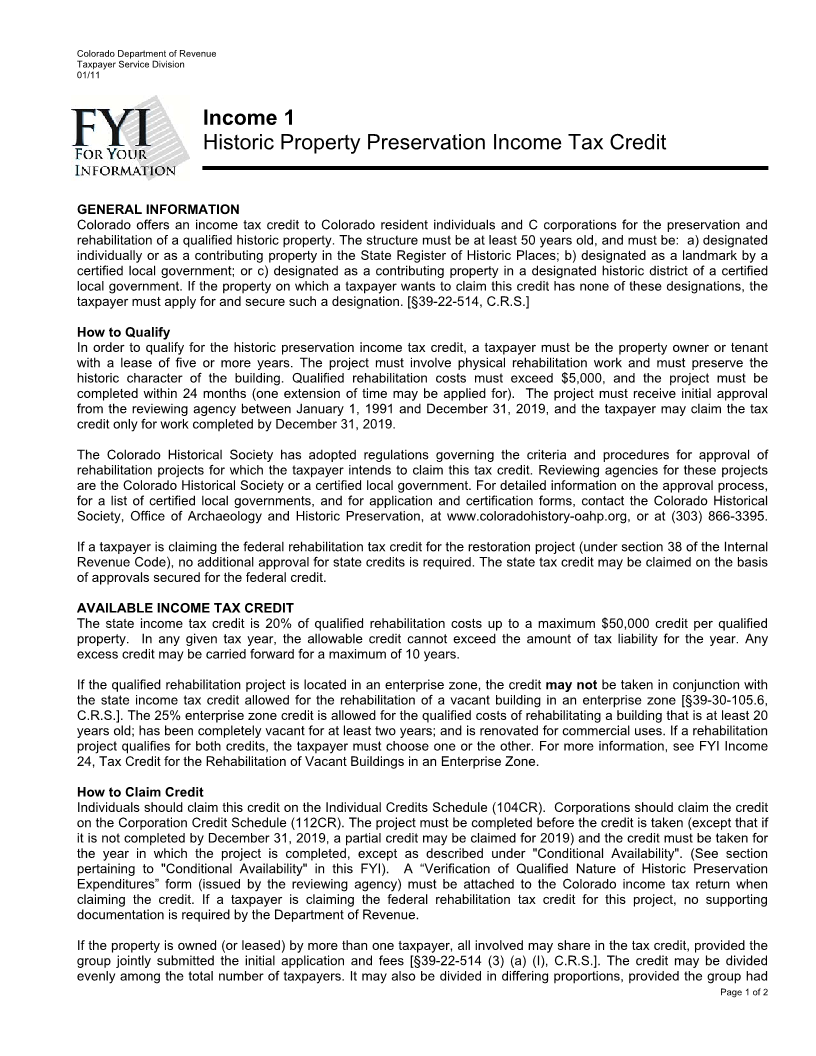
Enlarge image
Colorado Department of Revenue
Taxpayer Service Division
01/11
Income 1
Historic Property Preservation Income Tax Credit
GENERAL INFORMATION
Colorado offers an income tax credit to Colorado resident individuals and C corporations for the preservation and
rehabilitation of a qualified historic property. The structure must be at least 50 years old, and must be: a) designated
individually or as a contributing property in the State Register of Historic Places; b) designated as a landmark by a
certified local government; or c) designated as a contributing property in a designated historic district of a certified
local government. If the property on which a taxpayer wants to claim this credit has none of these designations, the
taxpayer must apply for and secure such a designation. [§39-22-514, C.R.S.]
How to Qualify
In order to qualify for the historic preservation income tax credit, a taxpayer must be the property owner or tenant
with a lease of five or more years. The project must involve physical rehabilitation work and must preserve the
historic character of the building. Qualified rehabilitation costs must exceed $5,000, and the project must be
completed within 24 months (one extension of time may be applied for). The project must receive initial approval
from the reviewing agency between January 1, 1991 and December 31, 2019, and the taxpayer may claim the tax
credit only for work completed by December 31, 2019.
The Colorado Historical Society has adopted regulations governing the criteria and procedures for approval of
rehabilitation projects for which the taxpayer intends to claim this tax credit. Reviewing agencies for these projects
are the Colorado Historical Society or a certified local government. For detailed information on the approval process,
for a list of certified local governments, and for application and certification forms, contact the Colorado Historical
Society, Office of Archaeology and Historic Preservation, at www.coloradohistory-oahp.org, or at (303) 866-3395.
If a taxpayer is claiming the federal rehabilitation tax credit for the restoration project (under section 38 of the Internal
Revenue Code), no additional approval for state credits is required. The state tax credit may be claimed on the basis
of approvals secured for the federal credit.
AVAILABLE INCOME TAX CREDIT
The state income tax credit is 20% of qualified rehabilitation costs up to a maximum $50,000 credit per qualified
property. In any given tax year, the allowable credit cannot exceed the amount of tax liability for the year. Any
excess credit may be carried forward for a maximum of 10 years.
If the qualified rehabilitation project is located in an enterprise zone, the credit may not be taken in conjunction with
the state income tax credit allowed for the rehabilitation of a vacant building in an enterprise zone [§39-30-105.6,
C.R.S.]. The 25% enterprise zone credit is allowed for the qualified costs of rehabilitating a building that is at least 20
years old; has been completely vacant for at least two years; and is renovated for commercial uses. If a rehabilitation
project qualifies for both credits, the taxpayer must choose one or the other. For more information, see FYI Income
24, Tax Credit for the Rehabilitation of Vacant Buildings in an Enterprise Zone.
How to Claim Credit
Individuals should claim this credit on the Individual Credits Schedule (104CR). Corporations should claim the credit
on the Corporation Credit Schedule (112CR). The project must be completed before the credit is taken (except that if
it is not completed by December 31, 2019, a partial credit may be claimed for 2019) and the credit must be taken for
the year in which the project is completed, except as described under "Conditional Availability". (See section
pertaining to "Conditional Availability" in this FYI). A “Verification of Qualified Nature of Historic Preservation
Expenditures” form (issued by the reviewing agency) must be attached to the Colorado income tax return when
claiming the credit. If a taxpayer is claiming the federal rehabilitation tax credit for this project, no supporting
documentation is required by the Department of Revenue.
If the property is owned (or leased) by more than one taxpayer, all involved may share in the tax credit, provided the
group jointly submitted the initial application and fees [§39-22-514 (3) (a) (I), C.R.S.]. The credit may be divided
evenly among the total number of taxpayers. It may also be divided in differing proportions, provided the group had
Page 1 of 2
